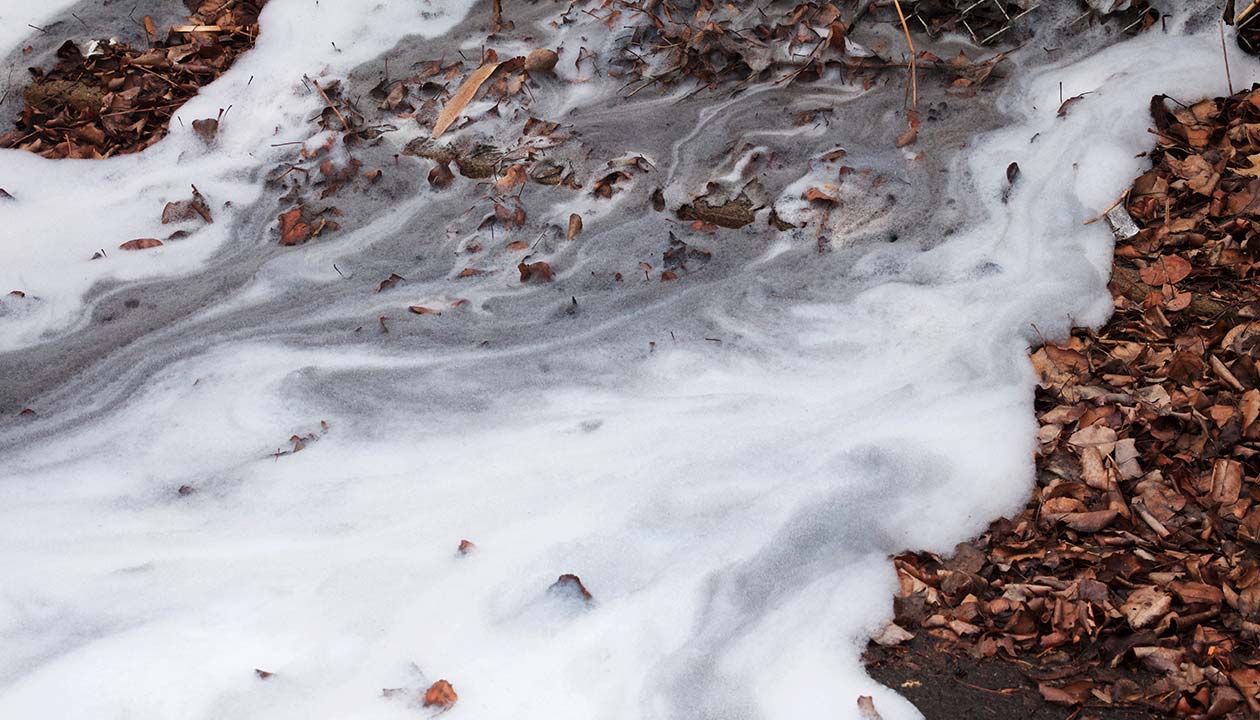If you received a cancer diagnosis after exposure to AFFF, Join the Many can help you file a lawsuit against manufacturers like DuPont, 3M, Chemours, and Tyco for negligence.
What Is AFFF?

Aqueous Film-Forming Foam (AFFF) is highly effective against fires that defy water because it forms a blanket that smothers the fire. It also works faster than other methods, which made it very popular for decades.
The DOD uses this foam on aircraft and ships because the closeness of munitions, fuel, and people makes fires more dangerous. AFFF deprives the fire of oxygen and is effective against large fires. It also coats hot fuel to avoid re-ignition.
Unfortunately, these great abilities come at a cost because they are incredibly harmful to our bodies. They can leak into runoff and groundwater nearby, contaminating local drinking water.
Exposure to these chemicals increases the risk of various cancers, especially after a prolonged duration.
AFFF products are common in locations such as:
- Military facilities
- Municipal services like firefighting training centers and fire departments
- Chemical plants
- Bulk fuel storage farms, terminals, and oil refineries
- Flammable liquid processing and storage facilities
- Merchant operations such as offshore platforms and oil tankers
- Aviation operations like hangars, aircraft rescue, and firefighting
History of Aqueous Film-Forming Foam (AFFF)

The use of AFFF dates back several decades to the early 1900s. According to the U.S. Department of Veterans Affairs, the DOD started using AFFF in the 1970s.
Popular manufacturers of this firefighting foam include 3M, DuPont, and Tyco Fire Products. Until fairly recently, manufacturers could use toxic chemicals known as per- and polyfluoroalkyl substances (PFAS) to make the foam.
PFAS present in the foam includes perfluorooctanesulfonic acid (PFOS) and perfluorooctane acid (PFOA). These chemicals are famous as “forever chemicals” because they don’t break down in the body or the environment.
Extensive research shows that PFAS are potentially carcinogenic to humans. AFFF manufacturers no longer use these chemicals, but they exist in previous products still in use.
The EPA also cautions that PFAS contaminates groundwater around airports, military bases, manufacturing companies, and other industrial sites.
Since these chemicals don’t break down for many years, they will likely move beyond the immediate area through groundwater.
The EPA conducted a study on U.S. waterways and AFFF contamination. The results showed about 900 cases of contamination where AFFF foam spilled or AFFF products were in use.
They continue to document cases where “forever chemicals” are present in water sources, but it’s difficult to determine the extent of contamination in our water sources.
Firefighters and people living near such areas or drinking water from sources near these areas can develop illnesses over time. Most lawsuits against AFFF manufacturers involve people claiming that the foam caused them to develop cancer.
According to International studies on firefighters, testicular cancer is prevalent in firefighters. The increased risk led to the disease becoming popular as the firefighters’ occupational disease.
The manufacturers were aware of the health risks associated with AFFF yet failed to provide adequate warning. They ignored valid evidence of the adverse effects of exposure to these artificial toxic chemicals.
This ignorance exposed the environment, private citizens, firefighters, and military personnel to life-changing health effects. If they claim they had no idea, it was their responsibility to conduct detailed research.
Overview of Research Findings

The EPA and the Centers for Disease Control and Prevention (CDC) acknowledge the higher risk of some cancers due to PFAS exposure.
The International Agency for Research on Cancer (IARC) highlights that PFOA is a class 2B carcinogen. Extensive research shows that the body cannot break down these chemicals, which accumulate in the blood and various organs.
PFAS can bind with blood proteins and remain for extended periods. Exposure to AFFF foam causes most firefighters’ blood to have excessive levels of up to nine fluorinated compounds.
PFAS got the name “forever chemicals” because they don’t break down in the body or the environment. If they break down at some point, it’s likely after several years.
Scientific evidence shows there’s a possible link between exposure to PFAS and particular cancers, including:
- Testicular cancer
- Prostate cancer
- Endometrial or ovarian cancer
- Pancreatic cancer
- Kidney cancer
- Leukemia
- Non-Hodgkin’s lymphoma
- Thyroid cancer
- Liver cancer
- Breast cancer
- Bladder cancer
PFAS exposure in AFFF firefighting foam can also cause other illnesses, such as:
- Preeclampsia in pregnant women
- Lower infant birth weight
- Thyroid disease (PFOS)
- Ulcerative colitis
- High cholesterol levels
- Lower antibody response to vaccines, particularly in children
- Immune system issues
- Triglycerides
- Infertility and increased time to pregnancy
- Gestational diabetes
- Changes in thyroid hormones
- Rheumatoid arthritis
- Cerebral palsy
- Lower antibodies
- Higher asthma severity
- Pregnancy-induced hypertension
If you’re a private citizen suspecting your cancer diagnosis is due to AFFF exposure, you should contact the team at Join the Many. We will evaluate your case and connect you with experienced attorneys who will fight on your behalf.
Lawsuit History

According to the EPA, 3M, the largest AFFF manufacturer, discontinued PFOS production in 2002. Other companies followed suit and began phasing out PFOA production later in 2006.
However, by this time, the people exposed to these toxic chemicals for extended periods already had symptoms of various illnesses.
Numerous AFFF lawsuits were filed against 3M, Chemours, DuPont, and other manufacturers as more research came to light.
In 2017, Chemours and DuPont paid a settlement of $670.7 for 3,550 injury lawsuits. These lawsuits involved PFOA pollution due to the Washington Works Plant in West Virginia.
The settlement also included $50 million for future liability payments for related claims over the next five years.
In March 2020, a jury verdict awarded Travis Abbot $50 million in his case against DuPont. He claimed that drinking PFOA-contaminated water caused him to suffer from testicular cancer.
In January 2021, Johnson Controls settled an AFFF class action lawsuit with 1,200 Wisconsin residents for $17.5 million. They claimed that PFAS contamination in wells within the Peshtigo/Marinette area caused exposure to disease and loss of property value.
AFFF lawsuits filed in Federal Court merged into multidistrict litigation (MDL) in the District of South Carolina.
Although some people refer to AFFF class action lawsuits, they are actually MDLs. Class action lawsuits involve people with similar or very similar injuries. AFFF lawsuits include people with a wide variety of medical issues and different cancers, so every case is independent.
The goal of an MDL is to streamline federal lawsuits filed in various circuits across the U.S. and submit them to one judge. There’s better coordination to ensure effective pre-trial proceedings and discovery.
The MDL filed in South Carolina’s Federal District Court ( MDL No. 2873) is before Judge Richard Mark Gergel. As of 16th June 2022, there were about 2586 open AFFF foam lawsuits, where the plaintiffs claim exposure to AFFF leads to cancer.
Accepted cases involve people with breast cancer, testicular, pancreatic, and prostate cancer. There are some pending cases involving blood cancers like lymphoma and leukemia.
Who Is Eligible for a Lawsuit?

Lawsuits are the most effective way to hold AFFF manufacturers liable for not warning consumers about the potential health risks associated with their products.
Any person who suffered severe health issues after exposure to AFFF can be eligible for an AFFF lawsuit.
People who use AFFF directly, such as chemical plant workers, airport workers, military personnel, and firefighters, have the highest risk of prolonged PFAS exposure. They regularly interact with AFFF over several years.
Indirect exposure to PFAS through the air, soil, and contaminated groundwater can also cause health issues. People living in communities near military bases and other facilities where there’s regular use of AFFF are at risk of developing health issues.
You can pursue an AFFF lawsuit if you suffer from any illnesses or conditions we mentioned above.
Damages in AFFF Lawsuits
You should consult a personal injury attorney immediately if you receive a cancer diagnosis after AFFF exposure.
An experienced personal injury attorney can share insights on proceeding with the case and the compensation to expect. Most AFFF lawsuits aim to get compensation for aspects such as:
Medical Bills
Medical expenses are an essential component of a personal injury claim. In most cases, a cancer diagnosis comes with regular expensive medical bills. Treatment often involves multiple procedures, extended hospitalizations, and life-saving medication.
You may require chemotherapy, radiation, surgery, and immunotherapy to boost the cancer treatment. Palliative care is also a consideration in advanced cases.
It’s your right to claim compensation for medical expenses involved with cancer treatment in your lawsuit.
Lost Wages
After a cancer diagnosis, some patients inevitably have to stop working temporarily. Although some people manage to work part-time during cancer treatments, others are unable to juggle the two due to the side effects.
The lost wages will accumulate as your cancer battle advances, especially if your treatment takes longer. Whether working part-time or unable to work, you’ll still miss out on a significant part of your regular wages.
It’s only fair to you to include these lost wages in your AFFF lawsuit.
Pain and Suffering
Cancer treatment is often agonizing for most people. Most cancers induce significant suffering but combining these symptoms with treatment can amplify the suffering.
Most patients also miss out on social events and activities due to the side effects of cancer treatments or cancer. They also lose relationships during treatment and lack the energy and time to socialize with friends and family.
No one deserves such isolation and suffering, mainly due to other people’s negligence. Pursuing legal action against the responsible manufacturers helps you hold them liable for their role in your situation.
Talk to Join the Many to find out how you can include your pain and suffering in the lawsuit.
What to Do After Exposure to AFFF

If you or a loved one developed health issues after exposure to firefighting foam, the most vital initial step is to seek medical attention. If you receive a cancer diagnosis, you should consider pursuing legal action.
The best way to ensure you get the compensation you deserve is by working with an experienced AFFF attorney to help with the legal procedures.
An experienced firefighting foam attorney can:
- Determine whether you’re eligible to pursue legal action
- Collect the necessary evidence to ensure a solid case
- File the claim on your behalf before state deadlines
- Negotiate an appropriate settlement on your behalf
- Argue the case in trial on your behalf, if there’s no agreement to settle
Join the Many connects you with attorneys to handle the legal procedures on your behalf at no upfront costs.
During your free case review, we will:
- Elaborate on your legal options to help you understand the process
- Evaluate your case and answer any questions
- Discuss the way forward to pursue your lawsuit against AFFF manufacturers
Statute of Limitations for AFFF Lawsuits

The statute of limitations is the law that limits the time you have to pursue legal action after discovering your injuries. Every state has individual statute limitations, but most states allow two years.
It’s essential to consult an expert as soon as possible to help file your lawsuit. If the deadline passes, you may not get another chance to get the compensation you deserve.
Join the Many Who are Here to Support You.
If you or a loved one are suffering from cancer or related illnesses following exposure to AFFF firefighting foam, you may have a valid case.
It’s time AFFF manufacturers took responsibility for their negligence, and we’re ready to fight for you.
At Join the Many, we believe the legal system exists to support people like you and not the big corporations. We understand that the legal process can be complex and daunting, so we handle all the heavy lifting.
We’ll connect you with the best legal team to fight your case on your behalf, even if it proceeds to trial in court. You don’t have to worry about finances as we’ll not ask for any payments upfront.

